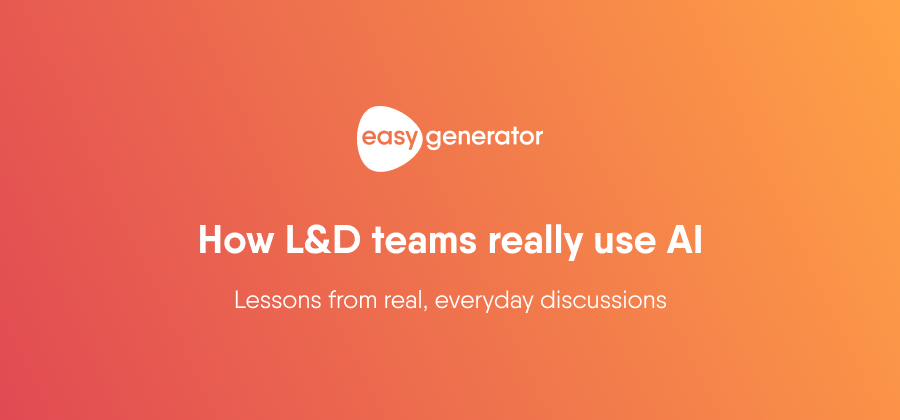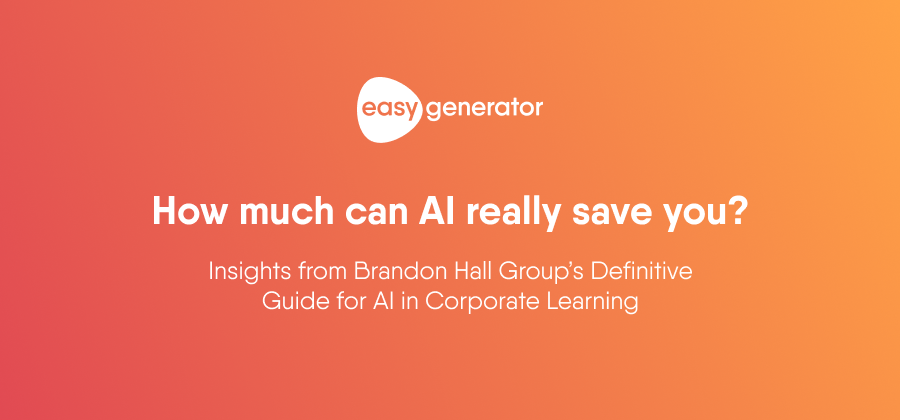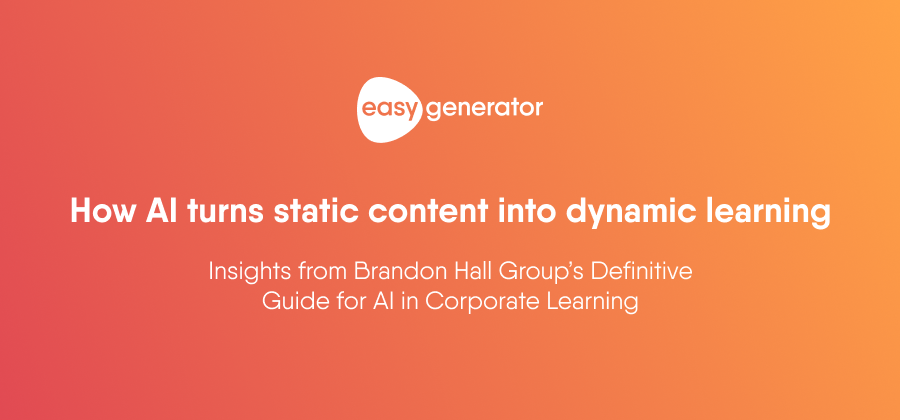5 examples of adaptive learning design in corporate training
Tired of one-size-fits-all training? Adaptive learning design customizes learning for every employee, making training faster, smarter, and more engaging.

Not everyone learns the same way or at the same speed. Some employees pick up new skills quickly, while others need more time or different types of training. That’s where adaptive learning design comes in. It adjusts training to fit each person’s needs, making learning more effective and engaging.
Companies use adaptive experimental design to personalize training. They can change the content by tracking progress to match what employees need. Active learning in the real world also helps by encouraging hands-on practice instead of passive learning.
In this article, we’ll explain adaptive learning design, why it matters, and five ways companies use it. We’ll also discuss how rapid e-learning and agile instructional design support adaptive learning.
What is adaptive learning design?
Adaptive learning design is a way to make training more effective by tailoring it to each employee. Instead of following a one-size-fits-all approach, adaptive learning systems track progress and adjust content accordingly to create personalized learning experiences.
If an employee already understands a concept, they can move forward without repeating unnecessary material. If they struggle with a topic, the system provides extra explanations, exercises, or even an alternative way of learning.
Many companies use AI-powered tools to streamline this process. These tools analyze how employees interact with training materials and make real-time adjustments. Some platforms suggest new learning paths based on past performance, while others change the difficulty level of quizzes or recommend additional resources. The goal is always the same: to make training more relevant and engaging.
Why adaptive learning is better than traditional training
Traditional training often forces employees to sit through lessons that may not be useful to them. Whether they are experts in the subject or completely new, everyone goes through the same training. This approach can be frustrating for experienced employees and overwhelming for beginners.
Adaptive design for learning solves this problem by recognizing that people learn at different speeds. Some employees might grasp a concept quickly and be ready to move on, while others need more practice. An adaptive system ensures that everyone gets the training they need without wasting time on what they already know. This leads to higher engagement, better retention, and improved productivity in the workplace, highlighting the benefits of adaptive learning.
The role of AI and data in adaptive learning
AI makes adaptive learning possible by continuously collecting and analyzing data on how employees learn. It tracks their strengths and weaknesses and then provides personalized recommendations. AI might offer additional reading, a video explanation, or a simplified approach if an employee struggles with a topic. If they excel, AI can suggest advanced content or let them progress faster.
Beyond personalization, AI-driven data analysis helps companies refine their training strategies. By identifying trends, organizations can see which learning methods are most effective and adjust accordingly.
This process, known as adaptive experimental design, allows companies to test, optimize, and enhance training programs over time. Integrating AI with active learning adaptive experimental design creates a smarter, more efficient learning experience that continuously evolves to meet employees’ needs.
5 ways companies use adaptive learning
1. AI-assisted content creation
Creating high-quality training materials takes time, and many L&D teams struggle to keep up with demand. AI-powered tools make this process faster and easier by helping companies build adaptive learning content in just a few steps. Instead of starting from scratch, AI can take existing documents, like PDFs, Word files, or PowerPoint presentations, and turn them into interactive courses. This allows organizations to share knowledge more effectively while reducing manual effort.
AI also helps employees without a background in L&D create well-structured, easy-to-follow courses. Subject-matter experts can generate a solid first draft of a course in minutes by simply providing a short description of what they want to teach. The AI model refines the content, ensuring it’s clear, concise, and suitable for learners. This means companies can tap into the knowledge of their entire workforce, allowing training to be created by the people who know the topics best.
Beyond content generation, AI can also enhance readability, suggest improvements, and even create interactive knowledge checks to reinforce learning. With built-in language support, companies can easily create training in multiple languages, making knowledge accessible to a global workforce. These AI-driven tools free up L&D teams to focus on strategic projects rather than spending hours on course development.
DID YOU KNOW?
When you have the insights but need the right words, Easygenerator’s EasyAI quick actions have you covered. Let AI handle the editing so you can focus on creating learning experiences that stick.
2. Microlearning with adaptive feedback
Microlearning is a way of breaking training into small, focused lessons. Instead of making employees sit through long training sessions, companies deliver short bursts of learning that are easier to absorb. When combined with adaptive learning design, microlearning becomes even more effective because it adjusts based on an employee’s progress.
If an employee is struggling with a topic, the system may offer extra explanations, simpler examples, or additional practice questions. On the other hand, if employees quickly understand the material, they can move ahead without spending unnecessary time on content they already know. This approach ensures that each person gets the right amount of support without feeling overwhelmed or bored.
Microlearning also fits well into a busy workday. Since lessons are short, employees can complete them between tasks without disrupting their workflow. This flexibility makes training more engaging and encourages continuous learning over time.
3. Gamified learning with adaptive challenges
Gamification makes learning more interesting by using game-like features such as points, rewards, and leaderboards. It helps employees stay motivated and makes training feel less like a chore. With adaptive learning design, gamified training adjusts based on each employee’s performance.
If someone is doing well, the system might increase the difficulty of the challenges, keeping them engaged and pushing them to improve. If someone is struggling, the system may provide hints, easier tasks, or additional practice to help them catch up. This way, employees receive challenges that match their skill level, making learning more effective and enjoyable.
By continuously adjusting to an employee’s progress, adaptive gamified learning ensures that training remains engaging while improving learning outcomes. It encourages employees to stay focused, complete their training, and apply what they’ve learned in real-world situations.
4. Cross-training for new skills
As workplaces change, employees often need to learn new skills to keep up with industry demands. Adaptive learning design makes cross-training more efficient by identifying what employees already know and tailoring their training to fill in the gaps.
Instead of giving every employee the same training, an adaptive system first assesses their current skills. It then recommends courses or learning paths based on what they still need to learn. This way, employees don’t waste time on material they already understand and can focus on gaining new knowledge that helps them grow in their roles.
Cross-training is especially important in industries where job roles are evolving due to new technology. By using adaptive learning, companies can help employees stay ahead of changes and prepare for new responsibilities. This makes the workforce more flexible and ready for future challenges.
Did you know?
Cross-training boosts knowledge retention and collaboration. In an Employee-generated Learning approach, employees reinforce their expertise while helping colleagues upskill, fostering a culture of continuous learning.
5. Adaptive compliance and regulatory training
Many companies require employees to complete compliance training on topics such as workplace safety, data protection, and ethical behavior. Traditional compliance training often takes a one-size-fits-all approach, making employees sit through material they might already know. Adaptive design for learning makes this process more efficient by focusing only on the areas where employees need improvement.
An adaptive compliance system starts by testing an employee’s knowledge before the training begins. If they already understand specific rules or policies, they can skip those sections and focus only on new or unfamiliar content. This saves time while ensuring that employees still meet all necessary compliance requirements.
By reducing unnecessary repetition and making compliance training more personalized, companies can improve employee engagement and ensure everyone understands the most important regulations. This approach makes training more effective and helps organizations maintain high standards of safety and ethical conduct.
How companies implement adaptive learning
The role of rapid e-learning
Rapid e-learning helps companies create and update training programs quickly. It works well with adaptive learning design because it allows companies to adjust training materials based on real-time data.
Agile instructional design and adaptive learning
Agile instructional design focuses on continuous improvement. Instead of creating a single training course and never updating it, companies collect feedback and make ongoing adjustments. This process ensures that training remains relevant and effective over time.
Organizations can create training programs that evolve with their workforce by combining agile instructional design with adaptive learning. Employees receive up-to-date content that matches their skills, job roles, and learning preferences.
Conclusion
Adaptive learning design transforms corporate training by personalizing content, improving engagement, and reducing wasted time. Companies can create company-tailored programs that meet employees’ needs by using AI, microlearning, gamification, cross-training, and adaptive compliance training.
Training will become smarter and more effective as businesses continue to embrace adaptive experimental design and active learning in the real world. The combination of adaptive learning, rapid e-learning, and agile instructional design is shaping the future of workplace learning. Now is the time for companies to integrate adaptive learning and take employee training to the next level.
-
 14 day trial with access to all features. Start with variety of course templates.
14 day trial with access to all features. Start with variety of course templates. -
 Get unlimited design inspirations. Level up your courses.
Get unlimited design inspirations. Level up your courses. -
 Upload your PowerPoint presentations. Get instant courses created.
Upload your PowerPoint presentations. Get instant courses created.




